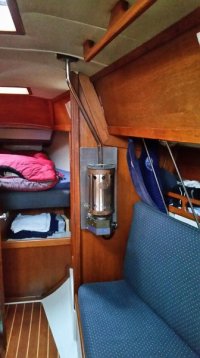I see. The issue with the attractive little "Cozy Cabin" seems to be moisture, and a worrisome open flame. An issue with diesel models is draw for teh fan--which can be 10 amps. Prices shoot up quickly. Insulation becomes important.
Even so, the Sig Marine CC may work for somebody like me, who has limited needs, an electric heater for dockside, and likes the small flue and lack of a big Charlie Noble.
For the record, here is Maine Sail on the topic, coped from 2006 at Sailnet:
I must respectfully disagree with the performance and design of the Force 10 or Cozy Cabin heater as it is now called. It is a PITA and very poorly designed for use in small confined spaces unless you like rain from condensation in your vessel.
Mine has been disconnected for the last three years. I'd rather go without heat than sop & drench the inside of my vessel due to the non-sealed & very humid combustion of the Force 10.
LP combustion can be about 50% moisture. Not ALL this moisture vents out the arguably undersized 1" flue vent and the boat windows quickly fog and condensation begins to form rapidly.
While it looks nice it is an awfully expensive decorative fireplace...
I agree with ceramic disc heaters like the Pelonis or similar. Nice dry heat. The Dickinson's are much nicer and MUCH drier as they employ sealed combustion meaning none of the LP moisture from combustion gets expelled into the cabin. They also incorporate a fan to circulate the heat where a Force 10 does not.
If you want the ultimate system then a Wallas or Espar system would be very sweet..
With two ceramic disc heaters, 3000 watts, I can do varnish work in temps to 0 F in Maine.. Electric is the easiest and least expensive up front cost, of course the monthly electric bill may choke you but at least you won't be lugging propane or diesel down the docks and under a winter cover either..

